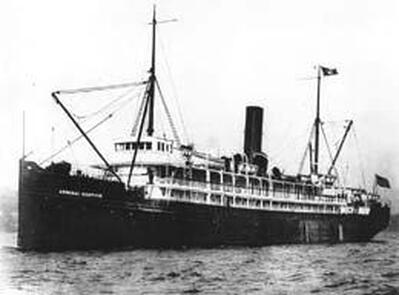Admiral Sampson Lost In Collision Off Seattle
By James Donahue
The Passenger Liner Admiral Sampson was carrying about 160 passengers and its crew when it left Seattle bound for Alaska on August 26, 1914.
There was fog that day, and it was getting thicker by the minute as the steamer inched its way into the Pacific and then started northward. The ship’s captain, Zimro Moore, ordered the engines checked down to a crawl speed of three knots, set up extra lookouts, and ordered the ship’s whistle sounded at regular intervals.
That was the way ships handled fog, heavy black rainy nights and snow storms before radar and other sonar detecting equipment was invented.
In spite of his precautions, the Admiral Sampson was struck broadside while passing Point No Point. The Princess Victoria, coming in with passengers on its way to Seattle, was also crawling at check speed, but the lookouts on both vessels either were not on their toes, or they simply failed to hear or see a warning.
Suddenly the Princess Victoria’s bow was slicing into the side of the Admiral Sampson’s steel hull. While they were still locked together passengers from the Sampson jumped to the deck of the Princess Victoria, climbing over her railings. It was well known that when there was a collision at sea, the vessel taking the blow to the bow had the best chance of remaining afloat.
After the Princess Victoria backed off, the Admiral Sampson sank quickly, going down stern first and taking with her 11 passengers, four crew members and Captain Moore. The wreck lies today in 320 feet of water.
The Princess Victoria’s forward bulkhead held and she remained afloat. She eventually limped into Seattle with a 14-foot gash in her bow.
The Admiral Sampson was built in 1898 for the American Mail Steamship Co. At the time of the sinking she was owned by the Alaska Pacific Company. She was a relatively small vessel, measuring 296 feet from stem to stern. Her superstructure was constructed of wood and she had a single stack.
By James Donahue
The Passenger Liner Admiral Sampson was carrying about 160 passengers and its crew when it left Seattle bound for Alaska on August 26, 1914.
There was fog that day, and it was getting thicker by the minute as the steamer inched its way into the Pacific and then started northward. The ship’s captain, Zimro Moore, ordered the engines checked down to a crawl speed of three knots, set up extra lookouts, and ordered the ship’s whistle sounded at regular intervals.
That was the way ships handled fog, heavy black rainy nights and snow storms before radar and other sonar detecting equipment was invented.
In spite of his precautions, the Admiral Sampson was struck broadside while passing Point No Point. The Princess Victoria, coming in with passengers on its way to Seattle, was also crawling at check speed, but the lookouts on both vessels either were not on their toes, or they simply failed to hear or see a warning.
Suddenly the Princess Victoria’s bow was slicing into the side of the Admiral Sampson’s steel hull. While they were still locked together passengers from the Sampson jumped to the deck of the Princess Victoria, climbing over her railings. It was well known that when there was a collision at sea, the vessel taking the blow to the bow had the best chance of remaining afloat.
After the Princess Victoria backed off, the Admiral Sampson sank quickly, going down stern first and taking with her 11 passengers, four crew members and Captain Moore. The wreck lies today in 320 feet of water.
The Princess Victoria’s forward bulkhead held and she remained afloat. She eventually limped into Seattle with a 14-foot gash in her bow.
The Admiral Sampson was built in 1898 for the American Mail Steamship Co. At the time of the sinking she was owned by the Alaska Pacific Company. She was a relatively small vessel, measuring 296 feet from stem to stern. Her superstructure was constructed of wood and she had a single stack.
